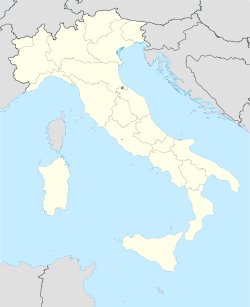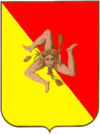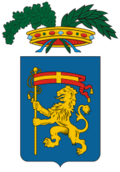Messina
| Comune di Messina | |
|---|---|
 Municipal coat of arms |
|
 |
|
| Country | |
| Region | |
| Province | Messina (ME) |
| Mayor | Giuseppe Buzzanca |
| Elevation | 3 m (10 ft) |
| Area | 211 km² (81.5 sq mi) |
| Population (as of 1 January 2005) | |
| - Total | 247,592 |
| - Density | 1,173/km² (3,038/sq mi) |
| Time zone | CET, UTC+1 |
| Coordinates | |
| Gentilic | Messinesi, Peloritani, Mamertini |
| Dialing code | 090 |
| Postal code | 98100 |
| Frazioni | See list |
| Patron | Madonna of the Letter |
| - Day | 3 June |
| Website: www.comune.messina.it | |
Messina (Missina in Sicilian) is the third largest city on the island of Sicily, Italy and the capital of the province of Messina. It has a population of 250,000 inhabitants in the city proper and about 500,000 in the metropolitan area.
It is located near the North-East corner of Sicily, at the Strait of Messina, just opposite Villa San Giovanni which is itself north of Reggio Calabria across the straits, on the mainland.
The main economical resource of the city is the port, both commercial and military, with several shipyards. Agriculture include cultivations of lemons, oranges, mandarin oranges and other fruit, vegetables and wine.
The city has been a Roman Catholic Archdiocese and Archimandrite seat since 1548 and is home to a locally important International Fair.
Contents |
History

Founded by Greek Colonists in the 8th century BC. There is a string of islands between the Greek Pelaponese plain of Messene and both the eastcoasts of Sicily and mainland Italy. Furthermore, the Greek city of Messene traces its ancestry back to the Mycenaen's. Messina was originally called Zancle (a native word for "scythe"—but in legend the name is attributed to King Zanclus) because of the shape of its natural harbour. (A municipality of its province, located at the southern entrance of the Strait of Messina, is to this day called 'Scaletta Zanclea'.) In the early 5th century BC, Anaxilas of Rhegium renamed it Messene in honor of the Greek city Messene (Greek: Μεσσήνη). See also List of traditional Greek place names. The city was sacked in 397 BC by the Carthaginians, then reconquered by Dionysius I of Syracuse.
In 288 BC the Mamertines seized the city by treachery, killing all the men and taking the women as their wives. The city became a base from which they ravaged the countryside, leading to a conflict with the expanding regional empire of Syracuse. Hiero II, tyrant of Syracuse, defeated the Mamertines near Mylae on the Longanus River and besieged Messina. Carthage assisted the Mamertines because of a long-standing conflict with Syracuse over dominance in Sicily. When Hiero attacked a second time in 264 BC, the Mamertines petitioned Rome for an alliance, hoping for more reliable protection. Although initially reluctant to assist lest it encourage other mercenary groups to mutiny, Rome was unwilling to see Carthaginian power spread further over Sicily and encroach on Italy. Rome therefore entered into an alliance with the Mamertines. In 264 BC, Roman troops were deployed to Sicily, the first time a Roman army acted outside the Italian peninsula.
At the end of the first Punic War it was a free city allied with Rome. In Roman times Messina, then known as Messana, had an important pharos (lighthouse). Messana was the base of Sextus Pompeius, during his war against Octavian.
After the fall of the Roman Empire, the city was successively conquered by the ???, then by the Byzantine Empire in 535, by the Arabs in 842, and in 1061 by the Norman brothers Robert Guiscard and Roger Guiscard (later count Roger I of Sicily). In 1189 the English King Richard I stopped at Messina in his path towards the Holy Land and briefly occupied the city after a dispute over the dowry of his sister, who had been married to William the Good, King of Sicily
Messina was most likely the harbour at which the Black Death entered Europe: the plague was brought by Genoese ships coming from Jaffa in Palestine. In 1548 St. Ignatius founded here the first Jesuit College of the world, which later gave birth to the Studium Generale (the current University of Messina).
The Christian ships that won the Battle of Lepanto (1571) left from Messina: the Spanish author Cervantes, who took part in the battle, recovered for some time in the Grand Hospital. The city reached the peak of its splendour in the early 17th century, under Spanish domination: at the time it was one of the ten greatest cities in Europe. In 1674 the city rebelled against the foreign garrison. It managed to remain independent for some time, thanks to the help of the French king Louis XIV, but in 1678, with the Peace of Nijmegen, it was reconquered by the Spaniards and sacked: the University, the Senate and all the privileges of autonomy it had enjoyed since the Roman times were abolished. A massive fortress was built by the occupants, and thenceforth Messina decayed steadily.
In 1847 it was one of the first cities in Italy where Risorgimento riots broke out. In 1848 it rebelled openly against the reigning Bourbons, but was heavily suppressed again. Only in 1860, after the Battle of Milazzo, the Garibaldine troops freed the city. One of the main figure of the unification of Italy, Giuseppe Mazzini, was elected deputy at Messina in the general elections of 1866.

The city was almost entirely destroyed by an earthquake and associated tsunami on the morning of December 28, 1908, killing about 60,000 people and destroying most of the ancient architecture. The city was largely rebuilt in the following year, according to a more modern and rational plan. Further damage was added by the massive Allied air bombardments of 1943, which caused thousands of deaths. Later, the city gained a Gold Medal for Military Valour and one for Civil Valour in memory of the event and the subsequent effort of reconstruction.
In June 1955, Messina was the location of the Messina Conference of western European foreign ministers which led to the creation of the European Economic Community[1].




Main sights
Religious buildings
- The Cathedral (12th century), containing the remains of Conrad, king of Germany and Sicily in the 13th century. After the earthquake of 1908, the cathedral was almost entirely rebuilt in 1919/1920. It had to be rebuilt a second time in 1943, after a fire following Allied bombings. The original Norman structure can be seen in the apsidal area. The façade has three late Gothic portals, the central one probably dating from the early 15th century, with noteworthy decorations. The architrave is decorated with a sculpture of Christ Among the Evangelists and representations of human figures, animals and plants. The tympanum is from 1468. The interior has a nave and two equally long aisles divided by files of 28 columns; some of the decorative elements are from the original edifice. Beside of that of Conrad IV, the tombs include those of Archbishop Palmer (died in 1195), Archbishop Guidotto de Abbiate (14th century) and Antonio La Legname (16th century). The mosaics in the apse are reconstructions. Noteworthy is the Chapel of the Sacrament (late 16th century), with scenographic decorations and 14th century mosaics. The bell tower remarkably holds the largest astronomical clock in the world, built in 1933 by the Ungerer company of Strasbourg. A popular touristic attraction is represented by the animated mechanical statues which every day at noon narrate important events of civil and religious history of the city.
- The Annunziata dei Catalani (late 12th-13th century). Dating from the late Norman period, it was transformed in the 13th century when the nave was shortened and the façade added. It has a cylindrical apse and a high dome emerging from a high tambour. Noteworthy is the external decoration of the transept and the dome area, with a series of blind arches separated by small columns. It clearly reflects Arab architectural influences.
- Santa Maria degli Alemanni (probably from the early 13th century), which was formerly a chapel of Teutonic Knights. It is a rare example of purely Gothic church in Sicily, as is witnessed by the arched windows and shapely buttresses.
- Sanctuary of Montevergine, where the incorrupt body of Saint Eustochia Smeralda Calafato rests.
Other
- The Fountain of Orion, located in the Cathedral square, built by Giovanni Angelo Montorsoli in 1547.
- The Fountain of Neptune, looking towards the harbour, built by Montorsoli in 1557.
- The Senatory Fountain (1619)
- The Four Fountains, though only two elements of the four-cornered complex survive today.
- Palazzo Calapaj, near the Cathedral, an example of 18th century Messinese architecture which survived to the 1908 earthquake.
- The San Ranieri Lighthouse (or Tower), from 1555.
- The Orto Botanico "Pietro Castelli" dell'Università di Messina, a botanical garden
- The Regional Museum, which hosts, among others, paintings from Caravaggio and Antonello da Messina.
- The Pylons, built in 1957 for a 220kV-overhead powerline across the Strait of Messina. At the time of its construction, the two pylons were the highest in the world. This powerline has since been replaced by an underwater cable, but the pylons still remain, protected as historical monuments, and freely accessible by tourists since 2006 summer.
Notable people
- Antonello da Messina, Italian painter and genius of the Renaissance, was born in Messina in 1430.
- Dicaearchus, Greek philosopher and mathematician, born in Messina 350 BC.
- Eustochia Smeralda Calafato, Italian Saint, was born in Messina in 1434.
- Francesco Maurolico, Italian astronomer and mathematician, was born in Messina in 1494.
- Filippo Juvarra, also spelled Filippo Juvara, Italian architect and highest exponent of the Baroque, was born in Messina in 1678.
- Hannibal Mary Di Francia, Italian Saint, was born in Messina in 1851.
Messina in literature
Many writers set their works in Messina, among them:
- Plutarch - The Life of Pompey (40 BC?)
- Giovanni Boccaccio - Decameron IV day V novel, Lisabetta da Messina - IV day IV Novel, Gerbino ed Elissa (1351)
- Matteo Bandello - Novelliere First Part, novel XXII (1554)
- William Shakespeare - Much Ado about Nothing (1598) and Antony and Cleopatra (1607)
- Molière Jean Baptiste Poquelin - L'Etourdi ou Les Contre-temps (1654)
- Friedrich Schiller - Die Braut von Messina (The Bride of Messina, 1803)
- Silvio Pellico - Eufemio da Messina (1818)
- Friedrich Nietzsche - Idyllen aus Messina (Idylls from Messina, 1882)
- Giovanni Pascoli - poem L'Aquilone (1904)
- Elio Vittorini - Le donne di Messina (Women of Messina', 1949) and Conversazione in Sicilia (Conversations in Sicily, 1941)
- Stefano D'Arrigo - Horcynus Orca (1975)
- Julien Green - Demain n'existe pas (1985)
Notes
External links
- (Italian) Official Municipality website
- (Italian) Messina website
- (Italian) University website
- (Italian) Prefettura website
- (Italian) Catholic Archdiocese of Messina-Lipari-Santa Lucia del Mela
- (Italian) Chamber of Commerce website
- (Italian) Theater of Messina Vittorio Emanuele
- (Italian) Tourism Office website
- (Italian) International Trade Fair website
- (Italian) All about sport in Messina
- Messina Port Authority
- (Italian) (Japanese) Football Club website
See also
|
|||||||||

